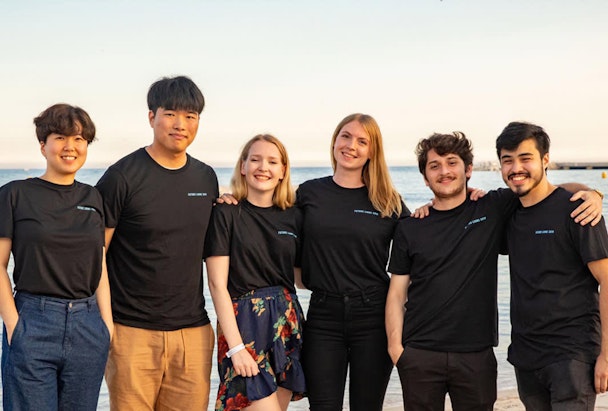‘The toughest task of lockdown’: nurturing young creative talent
Engaging junior talent during this ‘disorienting’ and ‘intensely frustrating time’ has been one of the biggest challenges in adland, according to top execs. Despite the many current limitations, here’s how agency leaders are nurturing young creatives even though the war rooms have gone dark and the whiteboards virtual.

Young creative talent, like the AKQA team above, needs more nurturing than ever, according to top agency execs.
One of the allures of advertising is the ability for up-and-coming talent to work hand-in-hand with top senior creatives to learn, win and grow. This year has made that physically impossible.
Renato Fernandez, chief creative at TBWA\Chiat\Day in Los Angeles calls “engaging talent that works for you and nurturing new talent – the toughest task of the lockdown.”
Grey chief creative Justine Armour takes it a step further: “You would not want to be a junior creative in 2020. None of the cool things that drew them to this job have come true, and there’s nobody right there to ask for casual help if they’re not getting it. Boundless creative energy constricted by the most disorienting work year in the history of humanity has made this an intensely frustrating time for junior talent.”
Given this context, top agencies are going to great lengths to retain the next generation of creative talent that is so vital to their business success. Here’s what six agencies are doing to retain and engage young employees.
Create a long-term career roadmap
The advertising industry is evolving before our eyes. Mergers, consolidation and shifts in the way agencies work with clients are occurring on a regular basis. Still, younger employees at the beginning of their careers are less interested in how their companies are evolving and more interested in how they can evolve personally.
That’s why it’s essential for agencies to map out an individual career trajectory to let talent know there is a long-term plan, says Danielle Wolfe, director of learning and development at Ogilvy. “Many companies are going through tremendous change as they respond to the shifting needs created by the pandemic. Don't use this as an excuse to delay career conversations. Embrace the chaos and look for opportunities to engage younger talent in the solutions. Doing so will signal your investment in their future and organically lead to more meaningful career paths.”
It’s important for senior leaders to remember, “young talent believes six months is six years,” says Chiat’s Fernandez, “so you need to make sure you clarify the steps it takes to grow at the right pace, but at the same time make sure there’s progress always on their way, otherwise they will seek it elsewhere.”
MediaMonks points to its four-year fellowship program, launched earlier this year, as a key differentiator for its talent efforts. “A lot of what we’re doing starts with changing the way we recruit, train and nurture talent. Our ambition is to build something that makes a real and meaningful impact on an industry that in my opinion, has limited itself by sticking to legacy models and ways of working,” says MediaMonks founder Wesley ter Haar.
The fellowships aim to “nurture young talent from underrepresented communities through dedicated apprenticeships with senior leadership, international work opportunities and to experience working inside our brand clients and tech companies firsthand.”
Last month, MediaMonks’ global HR team also launched LinkedIn Learning, “to give our teams the resources they need to fuel curiosity, chart a career path, broaden perspectives outside day-to-day work, and stay ready for what’s next,” says ter Haar.
‘Make sure they know failure is normal’
It’s a mistake for senior management is to assume that junior talent fully understands their assignment, their role and the expectations at hand. They don’t have the benefit of years of hard-earned wisdom.
One the keys is to, methodically, take the time to set them up for success, says Armour. “On every project, juniors need us to be clear on what they need to do to succeed, and they need almost constant candid, constructive feedback and encouragement. This means building time for teaching, nurturing and mentoring into every meeting on every project.”
Chiat’s Fernandez says to focus on offering balance. “For the young talent working for you, you have first to choose wisely the projects for them to work on — balancing entry point projects with some with more ambition. Creating for brands today is a complex mission and goes way beyond traditional advertising. The modern platforms are the perfect turf for young talent. They can excel. But you need to make it clear what you want from them. Otherwise, all you will have is ideas that live in the last pages of a deck that will never be produce.
And, perhaps most importantly, make certain that they have access to high-level meetings so they can see and hear what actually happens. “Inviting them to observe creative reviews between more senior teams so they know that none of us has got it all figured out,” says Grey’s Armour. “Give them a role in department meetings, make sure they know that failure is normal and that their weird junior voice matters even if they don’t win on every brief.”
Open your global doors
AKQA Casa (home) is the name of AKQA São Paulo’s office. Officially they’re located in a house, but right now, luck much of the world, it is closed. This has actually allowed the AKQA creative team to more democratic, according Diego Machado, global chief creative officer, AKQA.
São Paulo is an expensive city located in an expensive neighborhood. Working remotely allowed AKQA to hire young creatives and talent from any city in the world. “By worrying less about borders, we’ve been able access young creative talent, finding a new way of working. We constantly check in with our team members and work hard to provide guidance and support every step of the way.”
In the same collaborative and open spirit, the pandemic allowed AKQA’s young talent to access other studios in the world. “What in 2019 would have been extremely costly, Covid-19 allowed our young strategists for example to start working with strategists in our APAC studios, and other regions around the world in a new way,” says Machado. “That work exchange accelerated learning and connections across our network considerably and has allowed our young talent to evolve faster than ever, working from anywhere with anyone in the world. That’s the future.”
Elevate the onboarding experience
While onboarding has always been hit or miss depending on an agency’s culture, making people feel comfortable in this moment is more important than ever. In that respect, consistency in employee communication is key, says Claude Silver, chief heart officer at VaynerMedia.
Make onboarding and training for new employees immersive, engaging and ongoing, she says. This includes “how to work from home tips” in this training, with a nod to wellness, the need for self-care and taking mini breaks throughout the day.
Vayner encourages the creation of spontaneous “culture jam” sessions with people and icebreakers that facilitate employee connections outside of their usual teams or departments.
Silver says it also establishes “rules of the road” with its teams. “For example, every time you have a team meeting, spend the first five minutes checking in with each other. It normalizes things and it’s exactly what we would do if we were in a physical environment together. Build in opportunities for everyone to speak, so even the introverts are included… focus on outcomes, not hours.”
Pay extra attention to mental well-being
This is a very difficult time personally for many when it comes health, finances, family and many other factors. That’s why you need to be insanely curious about the wellbeing of your people, says Ogilvy’s Wolfe. “Don’t assume that everyone is okay. Younger generations who are just starting out their careers and learning the unspoken norms, might be unclear about what is appropriate to bring to work and therefore less likely to ask for help when they need it. If you notice changes in how someone on your team is behaving, for example, if they seem withdrawn or disengaged, don’t be afraid to check in and ask them how them how they are doing. For some, this could be the invitation that they need to ask for help.”
In many ways EQ is more important than IQ, says Silver. “Show your employees that you are human too and going through some of the same challenges they are. Make sure you and the other leaders in your organization are having frequent check-ins with your teams and individuals – this will help fight loneliness, isolation, and feelings that some may have such as, ‘Do I matter?’”
He says, “offer emotional support and encouragement. ‘I am here for you’ goes a very long way, especially when they see you are accessible and available.”
Grey’s Armour agrees. “Above all [exhibit] empathy, care, kindness. It’s difficult enough in a normal year leaving school and entering the workforce, can you imagine doing it now?”

